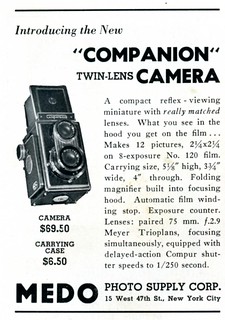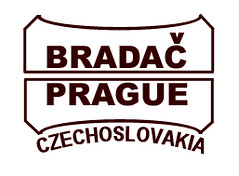Kamarad II
The Kamarad II is a Czechoslovak TLR made in 1937 by the Bradac brothers in Hovorcovice. The Nameplate has Kamarad engraved in it, with a line connecting the top of the K and the d. Underneath it MII is engraved. It has some style elements the later Flexarets would share with it, like an engraved plate with vertical lines between the lenses. These lines give it something of an art-deco look. The Kamarad II has an unusually fast lens (f/2.9) for its day. For comparison: Franke & Heidecke introduced f/2.8 lenses in 1950 on the Rolleiflex 2.8A.
Lenses
Both the taking and viewing lenses are the 75mm f/2.9 Trioplan. It can be stopped down to f/16. Focusing is done by turning either lens, they're internally connected. The viewing lens has an engraved distance scale that can be matched with a depth-of-field scale on the body. Sometimes the company logo is engraved where the aperture and shutter speed windows are on a Rolleiflex.
Shutter and body
The Kamarad MII has a (B, T 1–1/250s) Compur shutter. It is cocked with a small lever near the taking lens. A cable release thread is present. The shutter is fired with a Rolleicord style release under the taking lens.
The full metal body is covered in black leather. There's a small ruby window in the back for framecounting. The film is advanced by a winding knob on the right side. The tripod mount has a larger German thread.

|
| Medo "Companion" TLR 1937 advertisment image by Nesster (Image rights) |
Variations
After the Optotechnika takeover, the camera was renamed "Flexette". With a new Compur-S shutter, the Kamarad MII was renamed "Autoflex". The Kamarad II was sold in the United States under the name "Companion". Rare.
